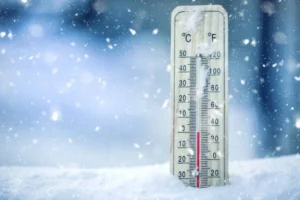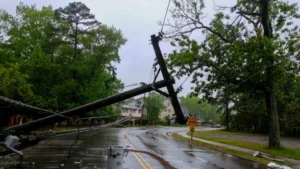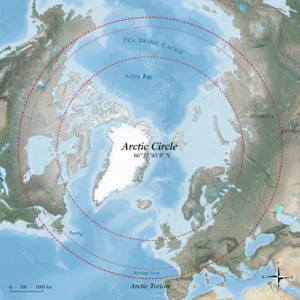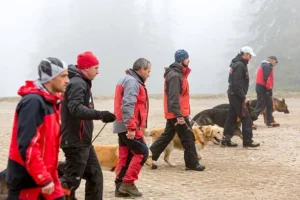VALLEY VIEW, Texas — Devastating storms and deadly weather in the US have claimed the lives of at least 20 people, injured hundreds, and left a path of destruction across Texas, Oklahoma, and Arkansas. Homes were obliterated, and a truck stop where dozens sought shelter was destroyed during the latest about of deadly weather to hit the central U.S.
The most severe damage occurred in an area stretching from north of Dallas to the northwest corner of Arkansas. Forecasters predict that on Monday, the most significant risk will shift eastward, threatening a vast region from Alabama to near New York City.
In Cooke County, Texas, near the Oklahoma border, seven fatalities were reported after a tornado tore through a rural area near a mobile home park on Saturday night, Texas Governor Greg Abbott announced at a Sunday news conference. Among the deceased were two children, aged 2 and 5. The county sheriff reported that three family members were found dead in a single home.
In Arkansas, eight people lost their lives statewide, as confirmed by Governor Sarah Huckabee Sanders during a Sunday evening news conference. An emergency official noted that two of these deaths were indirectly related to the storm: one person suffered a heart attack, and another was deprived of oxygen due to a power outage.
Among the deceased was a 26-year-old woman discovered outside a demolished home in Olvey, a small community in Boone County, according to Daniel Bolen from the county’s emergency management office. Additionally, one person died in Benton County, and two more bodies were recovered in Marion County, officials reported.
In Oklahoma, two fatalities were recorded in Mayes County, east of Tulsa. The injured included attendees of an outdoor wedding, officials said.
In Kentucky, three people have died. Governor Andy Beshear declared a state of emergency early Monday via a post on social media platform X, citing “multiple reports of wind damage and tornadoes.”
The small community of Charleston was directly hit by the deadly weather in the US on Sunday night, destroying several homes and causing widespread utility outages. “It’s a big mess,” said Rob Linton, a Charleston resident and fire chief of nearby Dawson Springs. “Trees are down everywhere. Houses have been moved. Power lines are down. There’s no water or power at all.”
The storm struck Charleston, an unincorporated community located two miles north of Dawson Springs. Dawson Springs had previously been devastated by a tornado in late 2021. Former two-term Governor Steve Beshear, the current governor’s father, grew up in Dawson Springs.
In Texas, Governor Greg Abbott reported that approximately 100 people were injured, and over 200 homes and structures were destroyed. Speaking in front of a wrecked truck stop near the small agricultural community of Valley View, Abbott noted that this area was one of the most brutal hit, with winds reaching an estimated 135 mph (217 kph).
“The hopes and dreams of Texas families and small businesses have been crushed by storm after another,” said Governor Greg Abbott, reflecting on the severe weather events that have battered the state. Earlier this month, storms claimed eight lives in Houston.
On Sunday, Abbott expanded the severe weather disaster declaration to include Denton, Montague, Cooke, and Collin counties, adding them to the areas already affected by storms and flooding since late April.
Hugo Parra, a Farmers Branch resident north of Dallas, recounted his experience of enduring the storm with 40 to 50 others in the bathroom of a truck stop. The storm tore off the building’s roof and walls, twisted metal beams, and left cars severely damaged in the parking lot.
“A firefighter came to check on us and said, ‘You’re fortunate,’” Parra recalled. “The best way to describe it is that the wind tried to rip us out of the bathrooms.”
Several people in Denton County, also north of Dallas, were transported to hospitals by ambulance and helicopter.
A Deadly Series Of Storms
The devastation marks the continuation of a grim month of severe, deadly weather in the US midsection. Tornadoes in Iowa last week resulted in at least five deaths and numerous injuries. These deadly tornadoes have struck during a historically severe season, exacerbated by the impacts of climate change. April recorded the second-highest number of tornadoes ever documented in the country.
Meteorologists and authorities issued urgent warnings for residents to seek shelter as the storms swept across the region late Saturday and Sunday. “If you are in the path of this storm, take cover now!” the National Weather Service office in Norman, Oklahoma, posted on X.
Harold Brooks, a senior scientist at the National Severe Storms Laboratory in Norman, attributed the recent string of tornadoes over the past two months to a persistent warm, moist air pattern.
As the sun rose on Sunday, residents emerged to a scene of chaos: overturned cars, collapsed garages, and anxious neighbors surveying the destruction. In one area, a group of neighbors sat somberly on the bare foundation of a home that had been reduced to rubble.
In Valley View, near the truck stop, the storms mercilessly tore roofs off homes and shattered windows. Debris, such as clothing, insulation, and bits of plastic, littered the landscape, wrapping around miles of barbed wire fencing that encircled grazing land in the rural area.
Kevin Dorantes, 20, was in Carrollton nearby when he received news of the approaching tornado. Frantically, he called his father and brother, urging them to seek refuge in the windowless bathroom. Thankfully, they followed his advice, sheltering there as the storm raged around them and emerged unscathed.
As Dorantes traversed the neighborhood, navigating through the maze of fallen power lines and destroyed homes, he encountered a family whose residence lay in ruins, reduced to a heap of shattered debris. Trapped beneath the wreckage were a father and his son, prompting friends and neighbors to mobilize and assist in their rescue efforts swiftly, Dorantes recounted.
“They were conscious but sustained severe injuries,” Dorantes remarked.
Widespread Power Outages
The severe weather left tens of thousands of homes and businesses without power in the storm’s path. Kentucky reported over 187,000 customers without electricity on Monday, per the tracking website poweroutage.us. Similarly, Alabama faced 84,000 outages, West Virginia 74,000, Missouri 70,000, and Arkansas 63,000.
In Oklahoma, inaccessible roads and downed power lines prompted officials in Claremore, near Tulsa, to announce via social media that the city was “shut down” due to the damage.
Additional Severe Weather On The Horizon
The system responsible for the latest about of severe weather is forecasted to shift eastward throughout the holiday weekend.
The start of the Indianapolis 500 was delayed by four hours due to the arrival of a powerful storm, prompting officials at the Indianapolis Motor Speedway to evacuate approximately 125,000 race fans.
Further severe storms are anticipated in Illinois, Missouri, Kentucky, and Tennessee. Forecasters warn that the risk of severe weather will extend into North Carolina and Virginia by Monday.












